Velotric Nomad 2X Review | Double the Squish, Double the Fun
This reimagined version of the Nomad 2 adds more power, better range, and a full air suspension for a cushier ride.
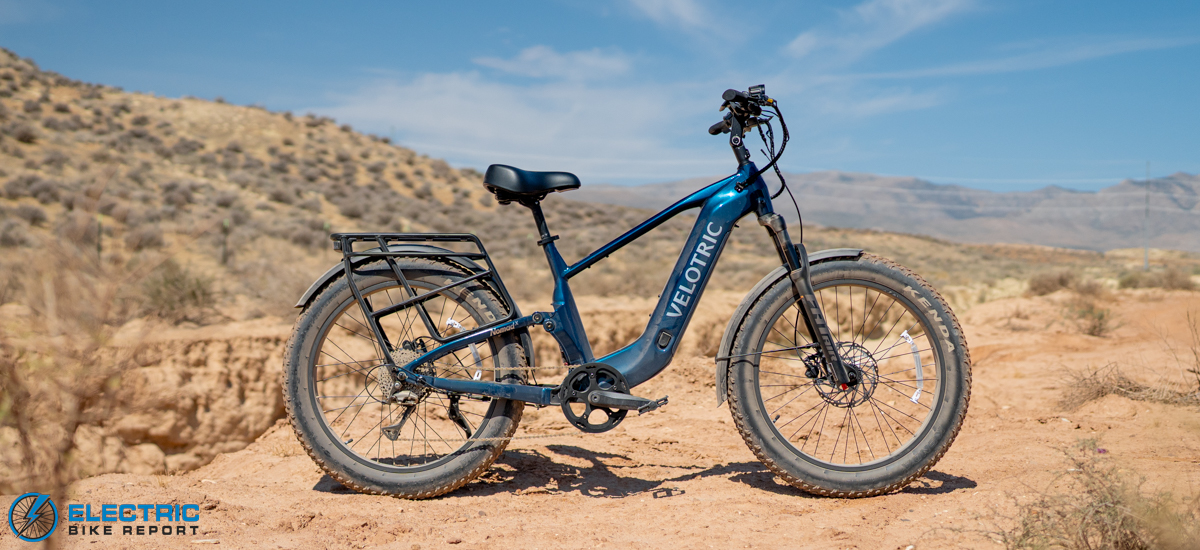
Nearly all fat-tire e-bikes have suspension forks to absorb impacts and smooth rough terrain, but without a rear shock, many bumps and rattles often still find their way to the rider. Outside of a handful of focused subcategories, such as speedy moto-style bikes or overpowered all-terrain monsters, full-suspension fat bikes are somewhat of a rarity.
Velotric aims to fill this niche with the Nomad 2X: a sportier, more powerful, and generally more off-road-capable version of its Nomad 2 fat tire e-bike.
The 2X has a more robust motor with a whopping 105 Nm of torque, a larger 802-Wh battery, and a full air suspension to complement its redesigned frame. Aside from those changes, the two bikes are largely the same, and the new version includes Velotric’s typical suite of impressive customization features.
Once paired with the Velotric app (or accessed in the display menu), riders can tune the feel of the ride through a variety of parameters. For example, the SensorSwap function allows users to switch between an active torque-sensing mode and a relaxed cadence-sensing mode depending on their preferences.
Additionally, there are three riding modes with a wide range of power levels for the pedal assist system (PAS). Velotric even allows granular control over the bike’s speeds, with the ability to set separate limits for the throttle and PAS anywhere between 12 and 28 mph.
In our experience, these features make Velotric’s e-bikes some of the most versatile rides on the market. With so many options to choose from, models like the Nomad 2X can appeal to riders of most ages, sizes, experience levels, etc.
So did the Nomad 2X meet our expectations based on our testing of similar models? Find out in our full review below!
Class 2 (throttle to 20 mph)
Class 3 (pedal assist to 28 mph)
 Pros
Pros- The Nomad 2X is super versatile! Its full suspension and powerful motor give it potential for hunting or off-road adventuring while also making it comfortable for cruising or commuting.
- It’s remarkably customizable, with both torque and cadence-sensing modes, separately adjustable throttle and pedal assist speeds, low, medium, and high-power riding modes, and more.
- Velotric’s pedal assist system is great. On the low-power end, the Nomad 2X delivers an active ride suitable for a workout, while the high-power settings make the ride effortless and fun.
- It has an exceptionally large payload capacity of up to 560 lbs! Velotric also advertises a towing capacity of up to 1,000 lbs.
- The Nomad 2X is jam-packed with features, including Apple Find My™, turn signals, a cruise control function, an MIK-HD cargo rack, and a new “Stealth Mode” that limits the bike’s speed and visibility when hunting.
- It pairs with the Velotric app, allowing users to track ride and health data, adjust the bike’s settings, and get over-the-air (OTA) updates.
- Looks are subjective, but we liked the bike’s overall design and glossy, automotive-quality paint job.
 Cons
Cons- We appreciate having options, but found a lot of overlap between the bike’s 15 assist levels. We’d prefer fewer settings with the ability to customize feel & power.
- The bike’s speed limitations were somewhat inconsistent in our testing, sometimes restricting us to the maximum we set, but other times exceeding it.
- The bike was generally comfortable thanks to its adjustability, but Velotric offers limited sizing options: a step-thru frame for shorter riders and a high-step for taller folks.
- Battery:48V, 16.7Ah (801.6Wh), IPX7, Certificated by UL 2271
- Display: 3.5″ Full color, High brightness, Bluetooth, Adjustable angle
- Motor: 48V, 750W, 105Nm
- Headlight:Light sensing 130 Lux /500 LM high-output integrated LED, adjustable angle
- Taillights:Braking Indicator, turn signal, rear light steady/flash, integrated with rear rack
- Pedal Assist: 3 Riding Modes x 5 PAS Levels
- Claimed Range:75 Miles (Pedal Assist), 50 Miles (Throttle)
- Throttle:Trigger-control, removable
- App:Velotric App
- UL Certification:UL 2271 & UL 2849 Certified
- Claimed weight: 80lbs
- Rider height range: 4’11” – 5’10” (Step-Thru), 5’10” – 6’5” (High-Step)
- Total payload capacity: 560 lbs
- Brakes: Tektro Hydraulic Disc Brake, 203mm Front/180mm Rear Rotors
- Fenders: Front and rear full coverage
- Fork: Air suspension 120mm travel with Lock-out, Nutted, Rebound adjustable
- Shock: DNM Air suspension, 165mm x 38mm Travel
- Frame: Triple-Butted Aluminum Alloy, Rear Wheel 80mm Travel
- Drivetrain:SHIMANO 8-speed, 48T Chainring, 11-40T Cassette
- Grips: Durable ergonomic grips, lockable
- Saddle: VELOTRIC comfort ergonomic seat
- Handlebar: Aluminum Alloy, Φ31.8mm, 700mm
- Kickstand: Aluminum Alloy, included, rear mount
- Pedals: Plastic
- Tires: KENDA 26×4.0″ eBike puncture-resistant tires
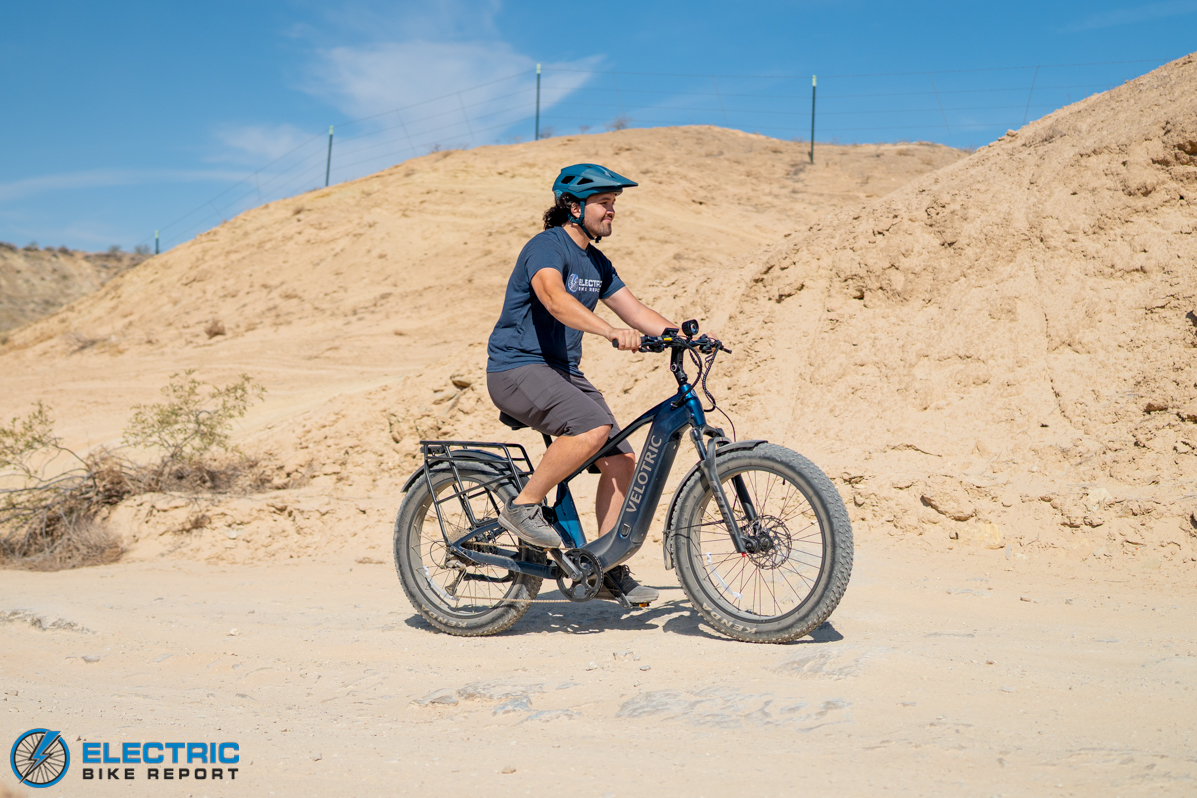
While all fat tire e-bikes can play confidently in the dirt, off-roading seemed to be the Nomad 2X’s focus. It’s a solid commuter as well, but it’s capable of longer and more demanding off-road adventures than the standard version of the bike.
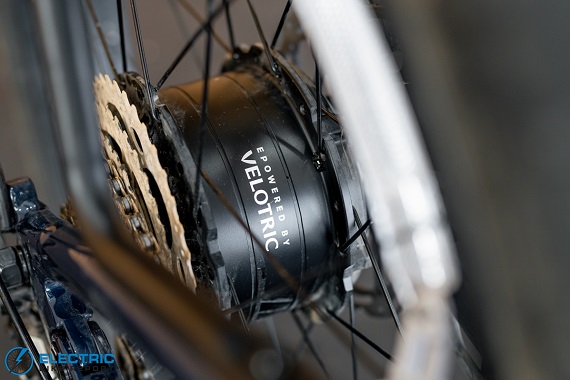
Velotric amped up the Nomad’s 750W hub motor; this version kicks out 105 Nm of torque and has a peak of 1400W.
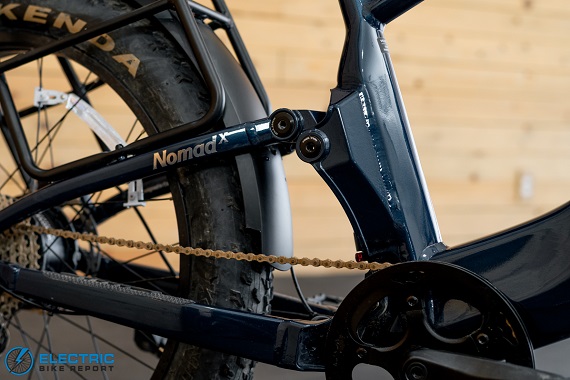
This sportier version of the Nomad includes a DNM rear shock with 38mm of stroke to cushion rough rides.
Velotric Nomad 2X Review: Speed Test
We have a few goals when conducting our Speed Test. The first and simplest is to ensure that every bike reaches its advertised maximum speed. Second, we want to get an understanding of the bike’s programming and power distribution. Third, we test the throttle’s acceleration to make sure its force matches the style of the bike.
In most cases, our testing process requires just one or two tests, but since the Nomad 2X has both torque and cadence sensing modes, three riding modes, and the ability to reach Class 2 (20 mph) and Class 3 (28 mph) maximum speeds, it was a little more complicated.
The three riding modes I mentioned previously are Eco, Trail, and Boost modes. Each sets a range of power levels for the bike’s five PAS settings, giving a grand total of fifteen PAS settings.
To keep things as simple as possible for this test, I performed four separate pedal tests using only the Boost riding mode (we expect most riders will use this high range of power) with both sensor modes and Class settings. My results are shown in the graph above.
As shown by the Class 2 torque sensor test, the bike had a good distribution of power with consistent increases in speed in its first few settings. The fact that my last three results were the same indicated that the 20 mph Class 2 limit was holding the bike back (at least on flat ground), although this is not uncommon.
In the Class 3 torque sensor test, my speeds were faster in most of the bike’s PAS settings. Except for a slight dip in PAS 2 where my pedaling might have been somewhat inconsistent (a normal thing when dealing with torque sensors that respond to rider input), the graph of the data again shows consistent increases in power.
This relatively linear pattern is generally what we like to see in this test, because it means that the extra speed and power you get when moving between settings is intuitive. In essence, the increases simply feel “right.”
The bike’s power levels in the Class 2 and Class 3 cadence sensor tests were also mostly evenly distributed. As the data shows, the bike exceeded the 28-mile-per-hour limit that I set through the Velotric app.
It’s unclear whether there were some programming bugs that needed to be worked out, but I noticed that the bike’s speed limitations were somewhat inconsistent throughout my testing. At times, I could pedal over the limit that I set using the app, while at other times, the motor would turn off and the bike would pull me back down to the preset maximum.
Based on previous experiences, I would guess this inconsistency is something that could be corrected with a firmware update through the Velotric app. As such, I don’t consider it a deal breaker, but it is something to be aware of, and I encourage the Velotric team to address it.
When testing the three riding modes, I noticed that switching between them seemed to adjust power levels along with the sensitivity of the torque sensor. In Eco mode, I had to push into the pedals with significant force to get power, while Boost mode required much less effort and more return for my effort.
With such a wide range of assist settings, power levels, and two sensor modes, I consider the Nomad 2X suitable for a wide range of riders. Those using the bike for exercise might choose PAS 1 or 2 in Eco or Trail modes using the torque sensor. Other riders on a casual cruise might opt for PAS 3 or 4 in Boost mode using the cadence sensor, and so on.
When testing the throttle, I found that the Nomad 2X felt strong and steady without being too punchy or feeling out of control. In other words, it felt just right!
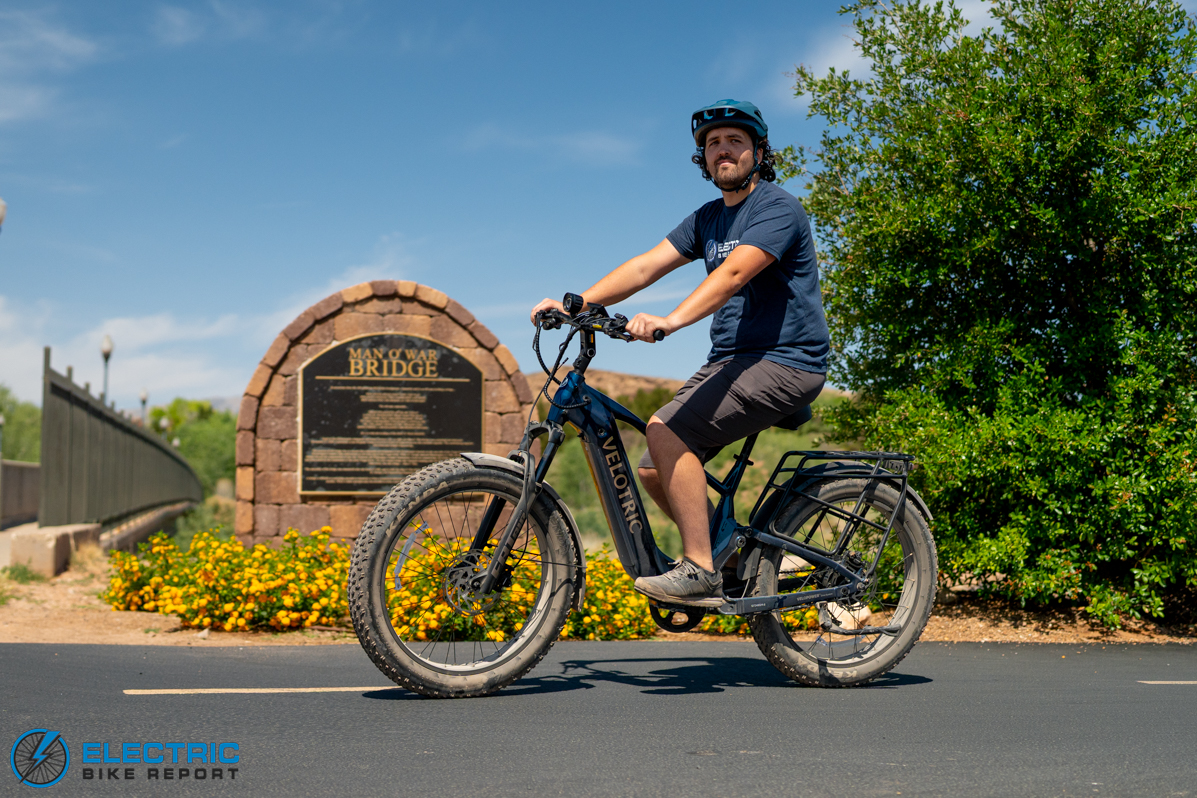
The Nomad’s full suspension makes riding on paved surfaces as smooth as silk.
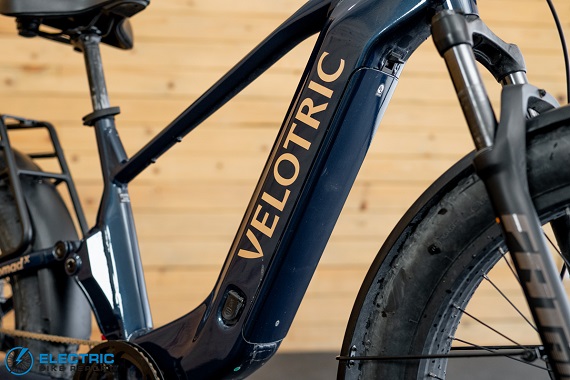
The bike’s 802-Wh battery is fully integrated into the down tube and boasts an IPX7 waterproof rating.

A thumb throttle sits close to the comfortable, ergonomic rubber grips.
Velotric Nomad 2X Review: Range Test

Velotric advertises a range of up to 75 miles with the Nomad 2X and its 802-watt-hour (Wh) battery. We tested the bike’s minimum and maximum range in the real world using the method explained in the graphic above. For our low-power test, we opted to use PAS 1 in Trail Mode, as the power levels in Eco mode required more effort to access than we think most riders will likely prefer.
Our test riders went 37.1 and 69.3 miles, making the Nomad roughly average in comparison to a pool of similar fat tire e-bikes we’ve reviewed—and those we consider most likely to be weighed when shopping (at least at the time of writing). The bikes used for comparison went 35.7 and 65 miles on batteries that averaged 888 Wh.
The Nomad 2X came out slightly ahead of both results with a significantly smaller battery, showing that its motor makes impressively efficient use of its battery capacity.
By dividing battery capacity by the number of miles traveled, we can calculate how many watt-hours per mile the motor used. The pool of bikes used for comparison used an average of 13.7 watt hours per mile (Wh/m) in their low power test and 24.9 Wh/m in their max assist test. The Nomad 2X used 11.6 and 21.6 Wh/m, respectively, so it was able to conserve two to three Wh/m in comparison, which allowed it to travel further.
The motor’s efficiency can also be examined when estimating the Nomad 2X’s Boost/PAS 5 test result based on the bike’s motor and battery specs. With its 750W motor and 802-Wh battery, the numbers suggest a ride time of roughly 64 minutes, yielding around 20 miles. The bike’s real-world result was nearly 2X (pun intended) as long, with an even 2 hours of ride time and 37 miles of distance.
While we did not quite reach Velotric’s advertised range using the Trail riding mode, we do think it would be possible to get more range when using Eco mode—if you’re comfortable with pushing a bit harder and getting more of a workout.
As it is, we’re pleased with the Nomad 2X’s results in this test, and we were impressed by the bike’s ability to provide a meaningful amount of power while offering enough resistance for a workout.
Based on our results, most of those using the Nomad 2X for leisure riding and commuting on paved surfaces should expect to ride for a few round trips before needing to recharge. It is worth noting, however, that riders choosing to use the cadence-sensing mode should expect fewer miles.
Additionally, those who tend to spend more time in rougher environments hunting or overlanding may end up on the lower side due to higher energy requirements. If you’re this type of rider, we recommend performing your own range test to see how the bike behaves where you plan to ride it.
Either way, the bike comes with a 3 amp charger that should have the battery refueled and ready to go in about five and a half hours when it is time to plug in.
Velotric Nomad 2X Review: Hill Test
We tested the Nomad 2X’s climbing ability using the method explained in the graphic above. Like most fat-tire e-bikes, which tend to do very well in this test, the Nomad had no trouble completing the climb.
At the time of writing, The Devil’s Backbone is a relatively new location for our Hill Test. The previous location, called Hell Hole Trail, was a significantly shorter segment with a different grade, so the same bike would perform differently at each location.
We are currently in the process of building our dataset at this new location, so a data-based comparison between the Nomad 2X and other similar bikes is not yet possible. The pool of bikes we have tested, which averaged 2:13 in their pedal tests, is small but diverse. The Nomad’s result was 25 seconds faster, which reflects the genre-defining power that is characteristic of fat-tire e-bikes.
Based on personal experience at our secondary test location, called Pilot Hill, I can say that the Nomad’s high torque output (105 Nm) and peak wattage (1400W) gave it a remarkably relaxed experience when pedaling uphill, even when using the torque-sensing mode.
When riding up this hill, I had to apply only light pressure on the pedals to reach the top and was nowhere close to being out of breath.
Based on Justin’s formal test and my personal experience, I can confidently say that the Nomad 2X is a great climber. In its highest level of pedal assist, the bike’s torque-sensing mode should allow most riders to tackle most hills. Those wanting an even easier experience can switch to the cadence-sensing mode for extremely low-intensity pedaling, or simply relax and rely on throttle power alone.
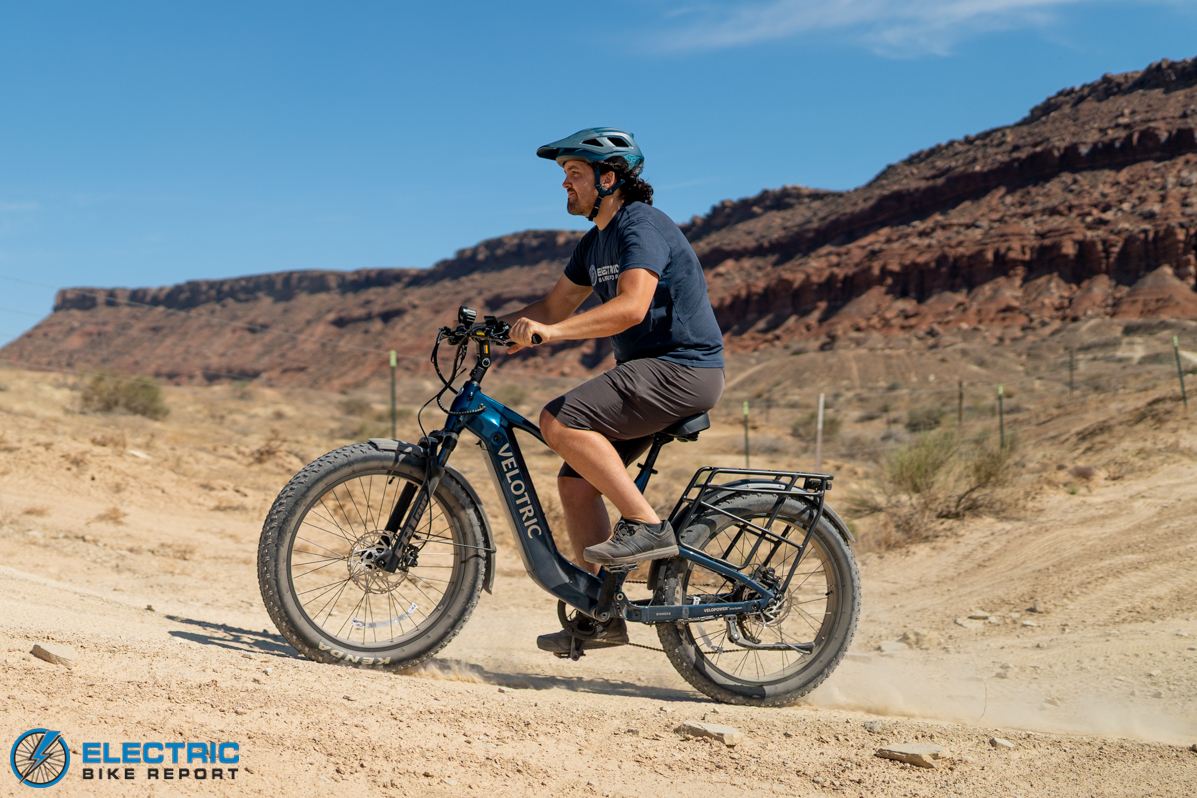
For hunting, the Nomad 2X offers a new “Stealth Mode” that dims the display, deactivates the lights and turn signals, and limits throttle and PAS speeds for a quiet approach.
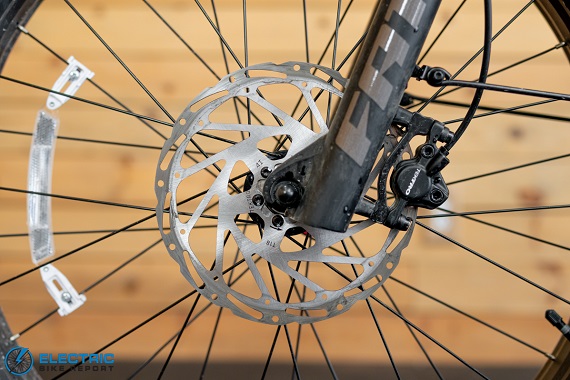
The Tektro TDK171 hydraulic brake system pairs 2-piston calipers with a 203mm front rotor and a 180mm rear rotor.
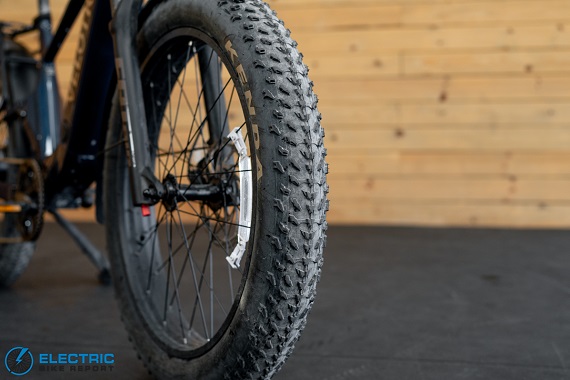
26×4” knobby fat tires offer grip on paved or unpaved surfaces, as well as extra cushion and great stability.
Velotric Nomad 2X Review: Brake Test

We used the process above to test the Nomad 2X’s Tektro hydraulic disc brake system, which is the TDK171 model with 2-piston calipers, a 203mm front rotor, and a 180mm rear rotor. The bike’s final score was 22’ 4”.
I compared that result to a selection of similar models we’ve tested recently, and those bikes averaged 22’ 5”, showing that the Nomad 2X’s stopping power is right around average.
Average performance is great, as it means that a bike is specced appropriately—but it’s important to consider that the Nomad 2X is about 7 pounds heavier than average (the bikes used for comparison averaged 81 lbs), which makes it harder to slow down.
Velotric compensated for the added weight by using two different-sized rotors. Most similar bikes we tested had 180-mil rotors on both wheels, but the Nomad’s larger 203mm front rotor helped to dissipate heat and stop the bike faster than if it had two 180mm rotors.
Going by feel, the brakes had good bite and modulation. They stopped the bike relatively quickly, although the Nomad did skid when braking hard, but not to an unusual degree. Overall, we give it two thumbs up for having safe and effective brakes.
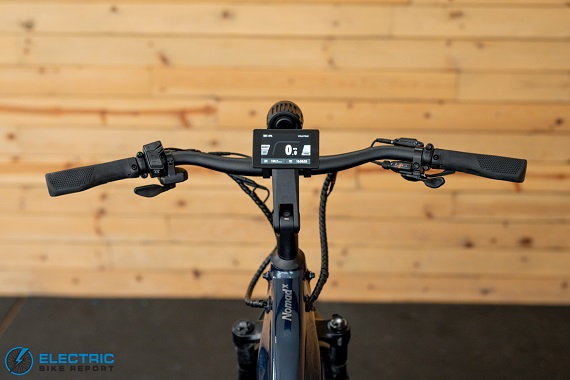
The bike’s 700 mm handlebars provided great stability, comfort, and steering control.

Velotric equipped the Nomad 2X with an adjustable stem, offering 60 degrees of rotation.

We appreciated the adjustable, supple air suspension fork from Trama with 120 mm of travel.
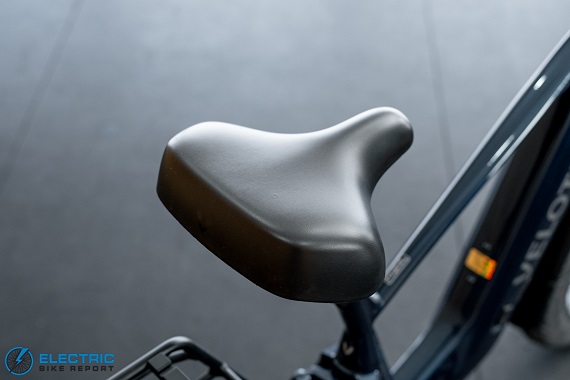
The huge, thickly-padded saddle felt more appropriate for a cruiser than an off-road beast.
Velotric Nomad 2X Review: Ride Quality
The subject of ride quality encompasses a variety of elements that contribute to how a bike feels to ride. From geometry to suspension to motor engagement and the bike’s user interface, the experience of riding a bike is multifaceted. This section will cover everything from the basic elements to more advanced features such as the Velotric app.
Beginning with sizing and geometry, the Nomad 2X is available in two sizes. The smaller of the two is a step-thru frame intended for riders from 4’11” to 5’10”, while the larger is a high-step frame sized for those from 5’10” to 6’5”.
Both frame sizes/styles include an adjustable stem that allows riders to alter their handlebar height and reach (both of which affect the riding position). The two frames have different ranges of adjustment in saddle height, with a 9.5” range on the ST model and a 12” range on the HS model.
An adjustable stem is relatively unusual on an e-bike essentially made for off-roading; most opt for a sturdier non-adjustable stem without the risk of loosening over time from rolling over constant bumps. Velotric’s choice to equip the 2X with an adjustable stem seems to be a cost-saving measure that allows the brand to offer the bike in fewer sizing options; the regular Nomad 2 has both a regular and large frame in both HS and ST styles.
My height of 5’11” placed me on the low end of the high-step frame’s recommended range of accommodation. The bike felt noticeably large, but I was able to find a comfortable fit thanks to the long seatpost and with the adjustable stem raised to its maximum height.
For those who are considering both versions of the Nomad 2, I would like to point out that the Nomad 2X has some significant differences in geometry compared to the standard model. The 2X has a longer wheelbase; we measured roughly 1313 mm, compared to the Nomad 2’s 1234 mm.
It also has a shorter stack (695 mm vs 715 mm) and a longer reach (420 mm on the ST and 460 mm on the HS vs 413 mm). Overall, this makes the 2X a bigger bike with a more forward-leaning and stretched-out riding position. Those who prefer bikes with a sportier feel instead of those that are more upright and relaxed will likely find the 2X more suitable.
Overall, I found the bike to be comfortable. I liked the rubber grips and the ergonomic sweep to the handlebars, but I found the massive cruiser-style saddle to be somewhat mismatched with the 2X’s geometry. If you find yourself in my camp, you may want to switch the standard saddle to a more slim, performance-style model to complement the bike’s sporty feel.
I tested the bike on our local network of paved shared-use paths as well as on a series of dirt paths and rocky desert roads. The bike’s full suspension, which includes a 120mm suspension fork and a shock with 38mm of stroke, made the ride smooth and comfortable in both types of terrain.
In terms of handling, the Nomad 2X felt appropriately sturdy and stable. It maneuvered well for its size, though its agility is undoubtedly slowed by the bike’s long wheelbase and weight.
The pedal assist system felt highly responsive in the torque-sensing mode, delivering power smoothly and adjusting quickly to changes in pedal pressure. The cadence-sensing mode was expectedly quick to engage, and as covered in the Speed Test section, had an intuitive distribution of preset speeds.
One other point of critique to mention is the Nomad 2X’s abundance of PAS settings. We appreciate having options, but the total of 15 settings felt excessive, and there was a significant amount of overlap between many of them. We’d prefer a smaller number of pedal assist settings with customizable power output through the app or display.
We’ve tested some similar off-road-centric e-bikes with more powerful motors, but the Nomad 2X’s peak output of 1400W and 105 Nm of torque allowed it to perform comparably.
The bike’s 750W nominal rating gives it an advantage over those with 1000W (or higher) motors; where those bikes will likely need to be registered to ride on roads, the Nomad meets the requirements of the widely adopted e-bike Class system and is street-legal out of the box.
Considering the bike’s user interface, we liked the well-organized color display. The control module on the left handlebar is a common component that we’ve seen on many other bikes; it effectively governs all of the bike’s features, but newer riders may need some time to learn what each of the buttons does (there are quite a few of them).
Nearly all of the bike’s customization features can be accessed through both the display menu and the Velotric app. These features include speed/Class adjustment, the SensorSwap feature, the ability to enable a cruise control function, an option for throttle speeds to be broken down incrementally in relation to the PAS setting, and even the ability to adjust how the brake light functions.
Through the app, users can also set up the integrated Apple Find My™ system, which allows the Nomad’s location to be tracked as long as it is near a Bluetooth-enabled Apple device. Riders can also track ride data and sync the app with Apple Health.
Overall, the Nomad 2X is versatile, highly functional, and loaded with useful tech and features. As I covered, we identified a few areas with room for improvement, but otherwise, the bike’s ride quality is great, as we’ve come to anticipate when reviewing a Velotric product.

The Nomad 2X features integrated lights, including a customizable brake light function and turn signals.
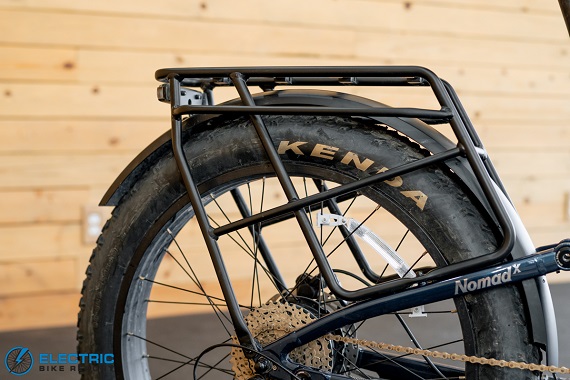
The bike’s rear cargo rack can carry a whopping 120 lbs and is compatible with 3rd-party MIK-compatible accessories.

Velotric’s custom color display presents a lot of information in a digestible, appealing format.
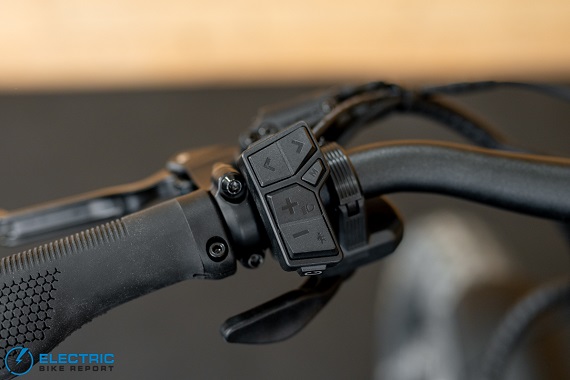
The Nomad’s multifunctional control panel has a learning curve, but it does its job well.
Velotric Nomad 2X Review: Summary / Where to Buy
We found the 2X to be a solid performer, with relatively average results when compared to the best fat tire e-bikes we’ve tested. Again, average performance is a good thing when it comes to e-bikes! Velotric clearly specced the 2X effectively, allowing it to perform well in all areas of our testing despite being slightly heavier than average due to its full suspension.
We identified a few areas for improvement, including the bike’s excessive number of pedal assist settings, limited sizing options, and occasional inconsistencies in its speed limitations.
Otherwise, we liked its powerful motor, responsive pedal assist system, extremely high weight capacity, and wide variety of customization options that allow the Nomad 2X to adapt to its rider’s preferences.
Our testing showed that the bike has a great distribution of power and speed with its programming. It also has an efficient motor and a sizable battery that gives it excellent range. It packs enough power to allow it to climb even intimidating hills easily. Finally, it has an effective brake system capable of stopping the bike safely.
Due to its robust motor and full suspension, we consider the Nomad 2X well-suited for off-road adventurers in the hunting, overlanding, and off-the-grid camping crowds. We also believe it would make a great commuter, exercise bike, and/or errand runner for those who want a bike with high stability, dependable power, a comfortable ride, and a sporty feel.
Happy Riding! Make sure to let us know if you have any questions or if you think we left anything out in this review of the Velotric Nomad 2X down in our comments section.



I have been waiting for a full squish fat tire ebike. I was considering the Mockwheel Obsidian but it had a cheap feel to it. I now have a Velotric summit 1. I put 3 in tires on it to soften off-road conditions as well as a upgraded air fork. I now have it pretty well dialed in. Wondering if it’s worth going to the Velotric new full suspension bike which weighs 20 lb more.
I guess my question is is how this bike compares to the Mockwheel Obsidian.
It was based on your review that I purchased the Yamaha moro 07 when it was on sale. Screaming deal and a great bike. Thanks
Great review and summary. Does the Nomad 2X have an integrated brake light?
Thanks for the review. 🙂
In other vids, it shows how the brake and turn signals work. The brake light has three distinct patterns to choose from. The headlight has an auto on/off feature.
Veloctric 2x. Please report controller amps. So many companies lie about the peak watts. Please report hill climb ability in both cadence sensor and torque sensor settings. Thanks.
Not a question about this bike but about a Velotric product. Since they have updated so many of their bikes recently, any chance they will update the Packer 1? It is a basic structure I am curious to try, but I don’t want to get “burned” like I did on the Xpedition (bought mine just a few months before the 2.0 came out). While I like the Xpedition 1.0, my time with it has shown me I would want to try a mullet setup next. I find the 20″ front wheel too harsh on impacts and bumps relative to the full-sized wheel on my regular bike. It may be a perception thing, along with an interpretation of the weight of the bike and such. The Packer seems like a good halfway point between a full-sized cargo bike option like the older school designs and the current crop of 20″ cargo bikes – I like the low center of gravity that the 20″ provides vs my regular bikes with a child seat, for example.
Also, other bikes I am considering with the same setup are Yuba Spice Curry Family of bikes (V3, New Curry, New Curry+, etc) and the Xtracycle Swoop – haven’t seen any good and detailed reviews on either of them but they come from well established legacy cargo bike companies so I trust the products are good, but a good review from you guys would be very much appreciated, 🤞
Just purchased before finding this. Even more confident in my choice. Difficult, but not impossible, to get it to Alaska; I’m grateful that my boss has a freight forward account for scheduled shipping.
I find it odd that in all the vids and reviews I checked before purchase, no one demonstrated it at more appropriate pressures for that tire size. I’ve been riding analog fat bikes since the 90s, and no one I know runs their tires at full pressure. I laugh when I see them doing sand at full pressure. That’s not how that works. Even on pavement, I’m at 12 psi or lower on 27.5×4.5 tires. Fat tire bikes really perform best at lower pressures in sand and snow, in my experience.
I looked at a lot of bikes and vids… I think this is the best in class for where I want to be at 64. I’m not ripping single track; I’m XCing, enjoying the ride, or cruising the many pavement trails. I already have an adequate for the weight bike rack, an FJ Cruiser for my daily, so taking it into the wilderness outside Anchorage is a short trip with a lot of comfortable ride time away from everyone but the bears and moose. The limit I’m facing as I age is not the desire to do it, but the ability to more comfortably be enabled to enjoy this amazing place I live.♥